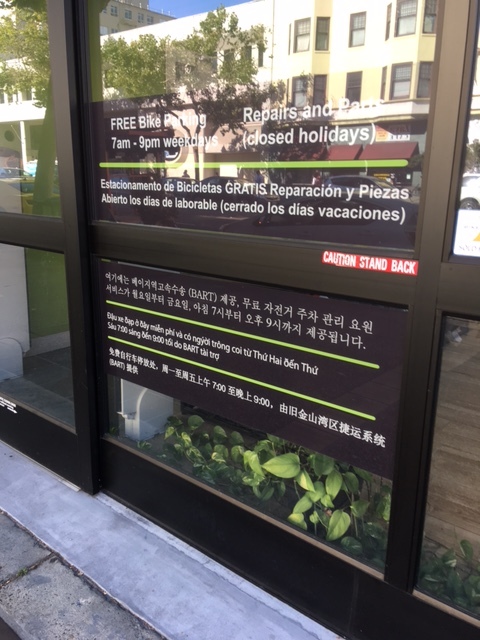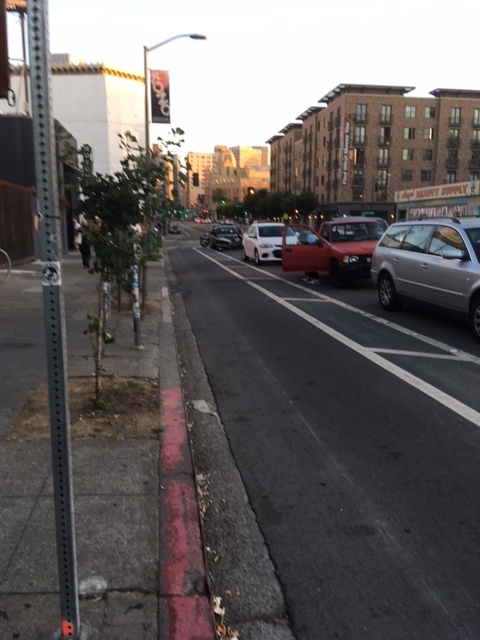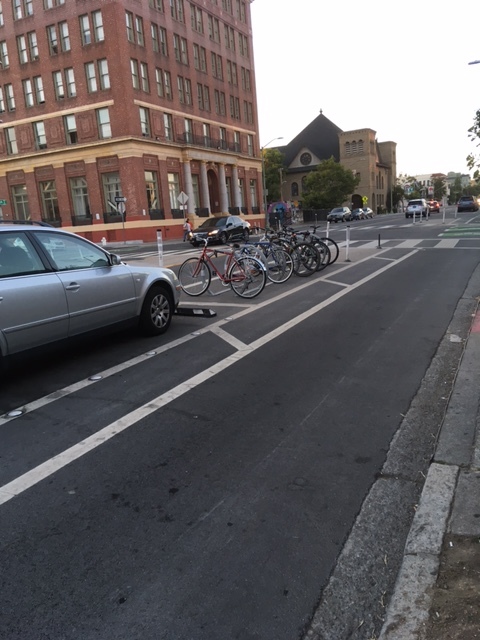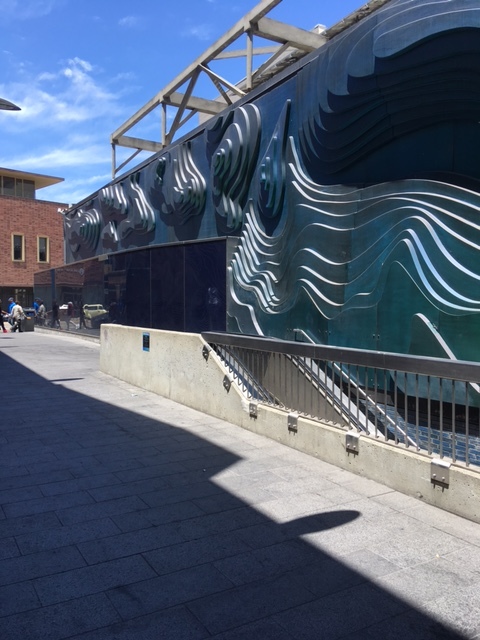Last Monday, I stretched out on the red eye flight from Oakland, California to Boston and tried to sleep. My thoughts were swirling as I tried to make sense of a four-day, whirlwind trip to the Bay Area for the 2017 YIMBY (Yes In My Backyard) conference, a gathering of pro-growth, pro-housing activists. Massachusetts Smart Growth Alliance, a statewide policy group, had invited a twenty-person delegation of new urbanist activists from across Massachusetts to attend the conference, in order to learn best practices to increase the housing stock in economically booming, housing-poor cities most evident in the Boston metropolitan area. As the only representative from Worcester, I want to share some insights gleaned from the experience— both inside the conference building and outside it, walking the streets of San Francisco and Oakland. Sleep on the red-eye was fitful and nightmare packed not only because of the changing time zones, but also because of disturbing observations and experiences. I have returned to Worcester with many more questions than answers to what Richard Florida has named “the new urban crisis.” I invite the reader to sit back and join me on these meandering musings that will bring us back to Worcester in the end.
Let me begin with two stories:
A Tale of Two Bagels. In search of bagels for breakfast, I found two places within a block or so of the conference on Broadway in downtown Oakland. Jimmy’s Deli, a humble abode with old, scuffed-up floors, dusty countertops and a simple pop-up letter menu on the back wall, reminded me of the down-home diners in Worcester. The deli was empty of patrons except for a father, who appeared to be wearing a bus driver’s uniform, talking in Spanish to his tween daughter. A sign on the front counter requested “no use of cell phones” in the store. The deli owner, in a thick accent, took my order for a plain bagel, toasted, with cream cheese. My yummy bagel cost me $2.30.
The next morning, I went to the other eatery, the Awaken Café, just a block away from Jimmy’s. This new establishment sported dark hardwood floors, flashy colored art placed strategically on the walls and clean, round tables. The establishment was full of latte-sipping white patrons, typing furiously on laptops or talking on cell phones. The young, blonde barista took my toasted bagel and cream cheese order and later served me at the table. The bagel was exactly the same as the day before at Jimmy’s, except the short-order cook had loaded the bagel mile high with cream cheese and added a little plastic cup with six, sad-looking grapes. The cost of my bagel and cream cheese was $4.59, twice what I paid at Jimmy’s the day before. “Those are some expensive, pathetic grapes!” I thought to myself.
I realized that this simple bagel was a tangible symbol of the struggle of ownership of downtown Oakland. As in any neighborhood in the process of gentrifying or upscaling, one sees the embers of the businesses that once thrived. Now, those businesses are being forced out by the businesses that cater to the new high-income residents. Oakland’s once desolate downtown got a shot in the arm during Jerry Brown’s tenure as Oakland mayor from 1999 to 2007. His $10K pledge to get 10,000 residents to live in downtown and in Jack London Square spearheaded a flurry of development of primarily market-rate housing. This trend continues under the leadership of the current mayor, Libby Schaaf. However, the new mayor has also pledged to protect tenants squeezed out of the hot housing market through such actions as developer fees to be used for affordable housing funds. The pressure is on though. This past year, landlords, out for profit, defeated legislation to protect the single room occupancy (SRO) hotels that have historically housed some of the most economically vulnerable residents. In 2004, there were 2,285 SRO units. This number has dwindled to only 1,311 in 2017, as this traditionally affordable housing has been converted to market-rate units, student dorms or even fancy boutique hotels.
One doesn’t have to be a sociologist to note the apparent battle for control of the streets of downtown Oakland. I’m walking to Desco’s, the upscale restaurant where Friday night dinner is planned for the Massachusetts YIMBY delegation. We eat prosciutto and melon, order $35 entries, drink orange wine, laugh and joke and plan the new urbanist revolution in our own backyards. Right outside on the streets though, I pass by people splayed on the sidewalk, asking for spare change or talking out loud to themselves in the thick air. I wait for the walk sign next to a man, down on his luck, whose unwashed smells waft over to me. He pumps his fists at the rushing cars and yells, “This is my street too! I deserve to be here!” Every single person I see in distress in downtown Oakland for the three days I am there is brown or black skinned, a tangible testimony of how institutionalized racism and classism intersects, preventing poor people of color from benefiting from the economic boom happening in this city. As I ponder the changing downtown with its new upscale restaurants, concierge housing, renovated theater spaces, I ask, will Jimmy’s Deli and the Awaken Café be able to thrive side by side? Or will Oaklanders, in a developing hot economy and real estate market, see the Awaken Cafés colonizing the Jimmy’s Delis of the area? Maybe on my next visit, I won’t find a place that will sell me a simple bagel and cream cheese for $2.30.
Downtown Oakland in a state of flux. Public art on old buildings is a sign or a symptom of current gentrification taking place.
Would you like a Kleenex? I am taking the BART train from Oakland to San Francisco to meet my friend who will be leading an Alfred Hitchcock tour starting on the exclusive Nob Hill. A heavy-set, brown skinned man in clean, casual clothes enters the train carrying a plastic bag filled with new mini Kleenex packs. He hands a pack to every passenger on the train along with a typed card that tells us his story. He has a five-year-old daughter and he has no home for her. Please think about buying this Kleenex to help her. I fish around for a dollar or two and hand it to the man and give him back the Kleenex so he can use the prop on his next ride. I turn to my seatmate and ask her, “Does this happen frequently here?” “People are getting evicted all the time around here,” she begins. “Have you seen all the tent villages? So many people living out on the streets. And don’t just think it’s because people are on drugs or have mental illness,” she continued. “The other day, I saw two children, almost babies, outside a tent, and a grandma was cooking over a makeshift stove. Families are out there. There’s not enough housing and what is there, many people can’t afford.”
She proceeded to tell me her own housing story. An artist from the Midwest, she came to the Bay Area to make and sell her art. Wealthy people can afford to purchase good artwork. However, living in San Francisco required her to work two full-time service jobs just to pay for her housing and other basic living expenses. Consequently, she had no time for her art. Something had to change, so she found an underutilized factory building in Oakland, and, with four other artists, appropriated part of it to cobble together a live/work/art space. They built walls and installed plumbing and made it somewhat habitable. The good news is that she now has lowered her housing costs so she can make art. I reminded her of the bad news: that a fire in December 2016 had taken thirty-five lives in a similar warehouse-turned-artist-collective. She shrugged her shoulders. What else can she do?
Tell me your housing story
Everyone in the Bay Area seems to have a housing story they want to tell. My friends hail from Oakland, San Leandro and Alameda, and they all say the very same line, “It’s good we bought when we did, or we would never be able to afford to live here now.” Even though one friend has a stable fixed-rate mortgage, he still toys with the idea of moving back east. “When it costs $9 round trip on BART, or when we go to a mediocre restaurant and the bill comes out to over $100 for the two of us, who can afford this?” One Uber driver in Oakland told me that he commutes over an hour just to drive his car for others. The driver finds it too expensive to live in Oakland, but plenty of well-to-do people in the city make for good business. Another Uber driver can’t stand the “everyone out for himself” climate in the Bay Area, and is about to uproot and move to Reno, Nevada. Another man bragged that he was doing his part in increasing the supply of needed housing by building an accessory dwelling unit (ADU), or granny flat, adjacent to his single-family home in a densely packed Oakland neighborhood.
California State Senator Scott Weiner, the policy wonk ally of the YIMBY movement who has filed statewide legislation to expedite the permitting process for new housing development, links his own journey to the desperate need to create new housing in housing-starved districts. After graduating from Harvard Law School over twenty years ago, Weiner moved to the gritty Castro neighborhood of San Francisco, to a rent-controlled apartment. Eventually, he was able to purchase a small condominium unit in the Castro neighborhood. His understanding that the easy avenues he experienced when he first moved to the city, finding adequate, affordable housing, are no longer available to newcomers; this prompted him to become a housing YIMBY advocate. Housing should not be a privilege for the few, but a right for the many.
The new urban crisis that Weiner is addressing in his work to increase urban housing stock and infill development is palpable, especially in the innovative, tech-focused, globally connected urban hubs and metropolitan regions of San Francisco, Portland, Seattle, New York City, Boston, Washington, DC, and other major American cities. People are flocking to these cities and their satellite communities in search of plentiful well-paying positions in the technology and finance sectors, opportunities for artists, and jobs in lower pay service-sector. Cities, benefitting from the innovation that occurs when people live and interact close to each other, are economically booming. Yet, housing supply often has not simultaneously risen to meet the demand of so many newcomers.
The urban population explosion in United States is also due to a larger cultural trend: that of affluent suburbanites moving back to the cities. In the 1960s, cities were the places that wealthy, predominantly white people were trying to escape, and where mostly poor people of color remained. At the time, federally subsidized highways not only sliced through and destroyed many poor urban neighborhoods, but the highways also became vehicles to transport the affluent to developing, sprawling, auto-dependent suburbs. Yet the baby boomer dream of owning a car and a single-family home with a water-thirsty lawn in a quiet suburb has given way to a new millennial dream of ditching the car and living in a neighborhood where one can easily find anything one needs. Walkable, densely packed, mixed-use neighborhoods with plenty of cultural amenities, the kinds of neighborhoods found more readily in urban areas, are now in high demand and shorter supply.
Here is how this housing crisis manifests in the Bay Area: Micro-units, which are SRO-type apartments for six-figure earning tech workers, rent for $1600 a month. New luxury building towers have darkened and empty units because they are purchased simply as investment properties by global super-rich elites. There is a surging tide of tent cities as evictions mount and affordable housing is converted to market rate units. According to a July 23 New York Times article, foreign investors spent more than $153 billion nationwide on real estate investments, pushing up housing prices, especially in the Bay Area, so that first-time home buyers’ dream of a house becomes out of reach. People on the bottom rungs fall off. Homelessness has surged in the past two years, and the census numbers are staggering: There are 2,761 homeless people in Oakland and 5,629 people in the larger Alameda county. “Is it fair that a wealthy person can purchase a second, third or even fourth home that is left vacant for most of the year, when so many don’t even have a primary home?” a friend asks. He points to the new luxury towers, which often hijack the best views, as a symbol of this affluent take-over of the city, just as the affluent benefited from the highways that moved them out to suburbs a generation before. Poor people once pushed out of neighborhoods by rich people’s highways are now shunted aside by rich people’s luxury urban towers.
For the first time ever, I felt depressed by a visit to the Bay Area. I saw from the window of the BART train the miles of tents precariously propped up under bridges and in vacant lots, the temporary fragile shelter of people who have nowhere else to go. I recall being viscerally overwhelmed when I traveled through India twenty years ago. Riding on the trains into New Delhi, I would see the miles of makeshift shacks, the women cooking over hot stoves, the men defecating off the empty train rails that served as the very public toilet. Wait! Am I in India? I became confused and disoriented. No, this is not India, but the United States. How can this injustice be sustainable? How would it be different here if we all were committed to building fair, healthy and loving places? Maybe I do need the Kleenex that the homeless man tried to give me on the BART train ride.
Most of the activists at the YIMBY conference were dedicated to addressing this housing crisis head on, framing the problem in the basic economic concept of supply and demand. If there is not enough housing for all, then housing supply must be increased in any way possible: through expedited permitting, zoning changes that support infill development, additional granny flats and vertical housing expansion. They mock naysayers (NIMBYs) who come up with excuses to put a halt on housing development—the people who speak out against new development projects at public hearings, holding up zucchinis that may not grow because of shadows from higher buildings, the people who complain about traffic or neighborhood preservation or the environment. How can groups such as the Sierra Club call themselves “pro-environment” and take a NIMBY stand against higher urban density that can help prevent the waste of resources from greenfield developments and help prevent the spread of exurban sprawl?
“Burn a developer,” a group of protestors scream in anger on the sidewalks below the YIMBY conference. Even though YIMBY conference goers were likely to discuss methods of maintaining and increasing affordable housing stock for the majority, YIMBYs are also perceived by some as evil free-market capitalists because YIMBYs support private developers who have taken the lead in building market-rate and luxury housing. The anger is palpable in Oakland where four new for-profit housing developments, often perceived as the cause of displacement of poor people, have been victims of arson during the construction phase.
Are new luxury housing projects a vehicle to increase needed housing stock and relieve pressure for all home dwellers (the YIMBY stance), or do these luxury units bring more hipster, affluent gentrifiers to neighborhoods on the margin, and thus end up displacing middle-income and poor people (the NIMBY stance)? This question is one that we have to ask and answer right here in Worcester.
San Francisco, Oakland and the Bay Area: A Warning and Wake Up Call for Worcester
It was a relief to get back to Worcester where the mortgage on my four-bedroom house on the west side is comparable in price to a rent-controlled studio apartment in a marginal neighborhood in Oakland. My housing story may resonate with so many other Worcesterites. We chose to root in this city because of its affordability, especially compared to the rising cost of living in the metropolitan Boston area.
Yet there is a definite change in the air here. Although it seemed laughable over twenty-five years ago to call Worcester the “Paris of the 80s,” there is something real and almost tangible about the potential renaissance that Worcester is now facing. New restaurants, many sourcing locally grown food, are opening up all the time. Millennial college students are starting to stay after graduation and offer their passionate leadership to build the innovation economy and the cultural life of the city. We’ve seen the rise of maker spaces such as Technocopia; the plethora of public art murals commissioned by POW! WOW!; the playgrounds built and buildings rehabbed through Working for Worcester, a citywide community service day founded by two Holy Cross students; and the youthful ideas funneled through the visionary tactical urbanist demonstration projects of Action! Worcester. These grassroots efforts have paved the way for private developers to finally note the potential that has been here all along: This city can retain and attract what Richard Florida refers to as the creative class. The developers’ guess is that Worcester is now primed to retain a larger percentage of students graduating from local colleges and universities, and to attract people priced out of the hot Boston housing market, especially because Worcester has commuter rail access to downtown Boston. Most of the large-scale for-profit housing projects currently being built are located in transit-oriented spaces in downtown or the Canal District, within walking distance of Union Station.
Here is where I diverge from some of my social justice friends. I don’t think there is anything inherently bad in a bit of upscaling. I attend yoga classes, hang out in Birchtree Bread Company, nursing my tea and writing for hours, appreciate the new murals on the windowless facades of downtown buildings, listen to the free music Elm Park concerts in the summer, and pick up kale and strange greens at the farmer’s market. For the past year, Jane Jacobs in the Woo has been proposing the ingredients for a recipe of a thriving Worcester: creatively reusing historic properties; supporting locally owned small businesses; building walkability and bike-ability into street design; maintaining well-designed sidewalks, street trees, public art, high-quality parks and open spaces; encouraging mixed-use compact development and human-scaled building designs that activate street life and public participation; and controlling development decisions.
The success of this so-called Jane agenda will undoubtedly herald its own negative unintended consequences: the sacrifice of our greatest assets of affordability and diversity as well as the displacement of poor people. San Francisco and the East Bay should serve as a foreshadowing of what might become of us on a small scale. Although I’m not going to stop pushing for Worcester’s adoption of a Complete Streets policy that provides for equitable use for walkers, cyclists and car drivers, and I dream of the day when I can safely bike from my home to Union Station, I am well aware that bike lanes are also known as “white lanes of gentrification.” At some point five or ten years down the road (and the change can happen very quickly), my guess is that Worcester will meet the tipping point. People will become priced out as beer gardens and artisanal bread bakeries take over the barbershops and bodegas. Current homeowners might applaud this shift, benefitting from an increase in housing prices. City leaders will get excited about the economic growth. Worcester will have made it. But I ask, at what cost?
Will a Worcester renaissance also increase the number of locals who are down on their luck?
My friend Joel co-owns a two-family in Somerville, a city we used to refer to as Slum-erville or Scum-erville, adjacent to affluent Cambridge. He feels lucky that he bought the house twenty years ago when rents were so cheap and even mortgages could be had with little money down. Now, the situation is reverse. Even in Somerville, firefighters and police officers, teachers and city workers struggle to afford a place to live in the city where they serve. Joel has one major regret: that Somerville did not anticipate its affordable housing crisis and therefore failed to put appropriate mechanisms in place to prevent it.
Worcester should not make the same mistake. Some may toss this article aside, questioning the very idea that we are anticipating an exciting and dangerous revival, instead pointing to the dirty streets and the drug users around downtown. What Worcester renaissance? they ask. I’m positing that yes, not only is the renaissance on the horizon, but we need to plan for the negative impacts of growth as well—that many of us will be closed out of its benefits and glory. Look at some troubling signs: All of the 875 luxury apartments being built in The Grid district and the new City Square development near the Downtown Common are market rate rents, starting at $1,200 a month for just a studio. We don’t have an inclusionary zoning policy in Worcester, so no units are set aside as “affordable.” The Worcester Redevelopment Authority (WRA) has identified the Midtown Mall on Front Street as one of dozens of properties slated for urban revitalization. The disinvested property in need of major physical repair also serves as an incubator for small businesses primarily owned by immigrants and people of color. A July 6, 2016 Worcester Telegram and Gazette article cites the tenants’ fears of being displaced from downtown if the WRA forges ahead with the redevelopment plan for the building.
Displacement of businesses and residents in the transit oriented downtown development is more than a potential threat. A sign hangs in the window of the Head Quarters Barbershop on Portland Street, thanking the shop’s loyal customers and informing them that “due to the unfair leasing process, August 31st will be our last day.” Owner Jahaira Gomez opened up the barbershop in this downtown location four years ago when most of the commercial properties nearby were vacant. Since then, she has built a healthy customer base of MCPHS pharmacy students, police officers and loyal clients who followed her from her former Pleasant Street location. MG2 Group, the current property owners of the Portland Street building that is a key parcel of the new “grid district” are raising the rent $500 a month on the new lease. Gomez points to the apartment complex also owned by MG2 Group across the street. Several friends living there have been forced to move as their rents have risen in the past year from $800 a month to over $1200 a month for a one- bedroom apartment. Gomez has felt the unwelcome chill from the property managers who have complained to her about her black and Hispanic clientele. “We are not on their agenda,” said one of the barbers employed by Gomez as he was cutting hair. Gomez who is planning to move her establishment to Shrewsbury Street, philosophizes, “If we want to make change here, we need to come together and make sure the change works for everyone.” In an upscaling neighborhood, who belongs and who is barred? Who is simply priced out?
For the past four years, Jahaira Gomez invested in growing her Head Quarters barbershop on Portland Street. She will be forced to move in August and believes she may have to relocate to another city that is supportive of her enterprise. A customer in the store warns, "The big fish are coming here and pushing out the little fish."
Worcester can look to other cities that are already tackling the crisis of affordability and displacement for solutions such as inclusionary zoning, rent control, community land trusts, vacant or empty homes taxes and land value taxes. Richard Florida, who is sometimes blamed for the current urban crisis because of his economic development strategy of enticing the creative class to settle in struggling cities, is now advocating the building of more affordable rental housing and the passing of living wage legislation. In July, Seattle passed landmark legislation to tax the wealthy (singles with incomes over $250,000) in order to fund affordable housing, improved transit and education. For Worcester’s particular situation, some of these solutions may make more sense than others, and we certainly have the people to come up with our own creative ideas. Worcester is blessed with a robust community of social justice activists, housing advocates and community development organizations. Now is the time to come together to research potential policy options and make citywide policy recommendations. We can enjoy the upcoming Worcester renaissance as it unfolds, but let’s just make sure it is healthy, sustainable and inclusive for all of us.










